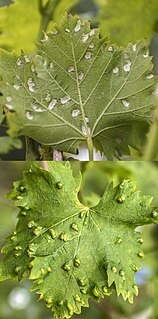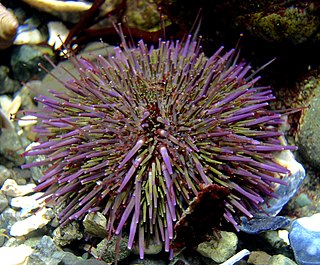 W
WAnasterias antarctica, commonly called the Cinderella starfish, is a species of starfish in the family Asteriidae. It is found in coastal waters in the Southern Ocean and around Antarctica.
 W
WThe California sea cucumber, also known as the giant California sea cucumber, is a sea cucumber that can be found from the Gulf of Alaska to Baja California. It is found from the low intertidal zone to a depth of 250 m (820 ft). They are most abundant in areas with moderate current with cobbles, boulders or bedrock. They are artisanally fished.
 W
WEriophyes tiliae is a mite that forms the lime nail gall or bugle gall. It develops in a chemically induced gall; an erect, oblique or curved distortion rising up from the upper surface of the leaves of the common lime (linden) tree Tilia × europaea.
 W
WEriophyes vitis is a mite species in the genus Eriophyes infecting grape leaves.
 W
WThe leather star is a sea star in the family Asteropseidae found at depths to 100 m (328 ft) off the western seaboard of North America. It was first described to science by Adolph Eduard Grube in 1857.
 W
WLeptometra celtica is a marine invertebrate and species of crinoid or feather star of the Leptometra genus in the family Antedonidae. It is found in the Atlantic Ocean around the coasts of north west Europe. The presence of L. celtica and L. phalangium is considered to be a good indication of nearby shelf breaks, general bottom currents, and areas of high gross productivity as they are suspension-feeders, hence their proliferation in productive environments.
 W
WMediaster aequalis is a species of sea star in the family Goniasteridae. It is native to the west coast of North America, ranging from Alaska to California. It is found in various habitats including beaches during very low tides, and at depths down to about 500 m (1,600 ft). Also known as the vermilion sea star, it is the type species of the genus Mediaster and was first described in 1857 by the American zoologist William Stimpson.
 W
WPisaster brevispinus, commonly called the pink sea star, giant pink sea star, or short-spined sea star, is a species of sea star in the northeast Pacific Ocean. It was first described to science by William Stimson in 1857. The type specimen was collected on a sandy bottom, 10 fathoms (18 m) deep, near the mouth of San Francisco Bay.
 W
WPisaster giganteus, the giant sea star or giant spined star, is a species of sea star that lives along the western coast of North America from Southern California to British Columbia. It makes its home on rocky shores near the low tide mark. It preys on mollusks. It can grow as large as 24 in (61 cm) in diameter. Its color varies from brown to red or purple.
 W
WProteroiulus fuscus is a species of millipede in the family Blaniulidae which can be found everywhere in Europe except for Albania, Andorra, Liechtenstein, Moldova, Monaco, Romania, San Marino, Vatican City, all states of former Yugoslavia and some European islands.
 W
WThe sandy anemone is a species of sea anemone in the family Actiniidae. It is native to very shallow water round the coasts of southern Africa between Luderitz and Durban.
 W
WThe purple sea urchin, Strongylocentrotus purpuratus, lives along the eastern edge of the Pacific Ocean extending from Ensenada, Mexico, to British Columbia, Canada. This sea urchin species is deep purple in color, and lives in lower inter-tidal and nearshore sub-tidal communities. Its eggs are orange when secreted in water. January, February, and March function as the typical active reproductive months for the species. Sexual maturity is reached around two years.
 W
WTurritopsis nutricula is a small hydrozoan that once reaching adulthood, can transfer its cells back to childhood. This adaptive trait likely evolved in order to extend the life of the individual. Several different species of the genus Turritopsis were formerly classified as T. nutricula, including the "immortal jellyfish" which is now classified as T. dohrnii.